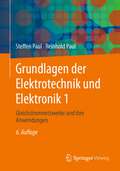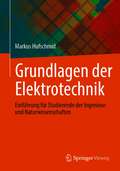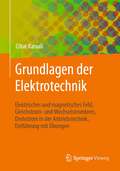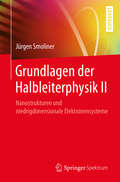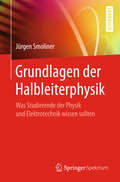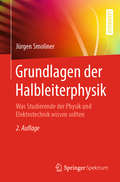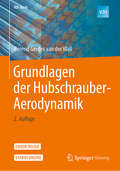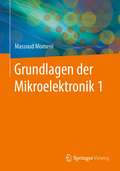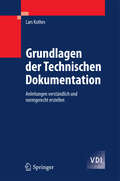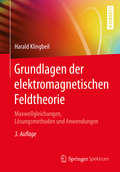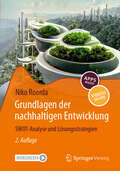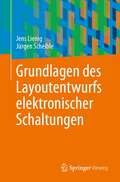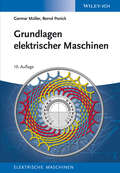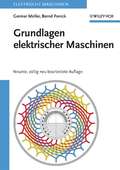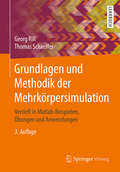- Table View
- List View
Grundlagen der Elektrotechnik und Elektronik 1: Gleichstromnetzwerke und ihre Anwendungen
by Steffen Paul Reinhold PaulDie gut eingeführte dreibändige Einführung in die Elektrotechnik und Elektronik hilft, die Elektrotechnik als ein Gesamtgebiet zu begreifen, das nach einheitlichen Prinzipien beschrieben werden kann. Der vorliegende Band 1 umfasst stationäre Vorgänge in elektrischen Netzwerken. Die Einführung von linearen und nichtlinearen resistiven Bauelementen erlaubt die Betrachtung des nichtlinearen Grundstromkreises durch Kleinsignalanalyse. Verfahren der Analyse von Gleichstromnetzwerken werden ebenso behandelt wie Methoden der Schaltungssimulation. Der Studienanfänger arbeitet mit Begriffen, die er aus der Schulzeit kennt. Die vorliegende 6. Auflage wurde um moderne Form der Zweitorbeschreibung ergänzt. Band 2 behandelt die Grundgesetze elektromagnetischer Felder, elektrische Erscheinungen in räumlichen Leitern und Nichtleitern, den Magnetismus, die elektromagnetische Induktion, Kräfte und Energiewandlung im elektromagnetischen Feld. In Band 3 werden zeitveränderliche Vorgänge in Schaltungen sowie die Wechselstromrechnung besprochen. Die Zielgruppen Studierende der Elektrotechnik und Elektronik sowie angrenzenden Studiengängen, etwa Wirtschaftsingenieurwesen oder Systems Engineering in Bachelor- und Masterstudiengängen.
Grundlagen der Elektrotechnik: Einführung für Studierende der Ingenieur- und Naturwissenschaften
by Markus HufschmidDer Inhalt des Buches umfasst sämtliche Themen von den Grundbegriffen über die Netzwerkanalyse, der Wechselstromtechnik bis zu den elektrischen und magnetischen Feldern, inklusive einem kurzen Kapitel zu den Grundlagen der drahtlosen Übertragung. Es wurde darauf geachtet, dass für das Verständnis der ersten paar Kapitel nur wenig mathematische Vorkenntnisse erforderlich sind. Im Verlauf des Buches nehmen auch die mathematischen Anforderungen kontinuierlich zu. Dies widerspiegelt die Tatsache, dass in einem üblichen Curriculum die Grundlagen der Elektrotechnik und die Grundlagen der Mathematik parallel vermittelt werden.
Grundlagen der Elektrotechnik: Elektrisches und magnetisches Feld, Gleichstrom- und Wechselstromkreis, Drehstrom in der Antriebstechnik, Einführung mit Übungen
by Cihat KaraaliDas Buch hilft den Studierenden sowie den Entwicklern bei einer strukturierten Vorgehensweise zur Lösung von allgemeinen elektrotechnischen Aufgabenstellungen. Systematisch zusammengefasste Themen wie elektrisches und magnetisches Feld, Gleich- und Wechselstromkreis und Drehstrom in der Antriebstechnik sind in einem Werk mit ausführlichen Ableitungen der mathematischen Verknüpfungen sowie schematischen Darstellungen zusammengefasst. Das Buch kann auch als inhaltliche Formelsammlung angewendet werden. Auf die schematischen Darstellungen sowie ausführlichen Ableitungen wird viel Wert gelegt.
Grundlagen der Funktionswerkstoffe für Studium und Praxis
by Janko Auerswald Pius PortmannDas neue Lehrbuch zu Funktionswerkstoffen bietet angehenden Ingenieurinnen und Ingenieuren einen motivierenden Einstieg in die Werkstoffkunde dank der ausführlichen Darlegung der Grundlagen und einem starken Praxisbezug.
Grundlagen der Halbleiterphysik II: Nanostrukturen und niedrigdimensionale Elektronensysteme
by Jürgen SmolinerDieses Lehrbuch bietet Ihnen einen kompakten und verständlichen Überblick über die Physik von niedrigdimensionalen Elektronensystemen und den elektronischen Eigenschaften von Halbleiter-Nanostrukturen. Es eignet sich hervorragend für Studierende in höheren Semestern, die fortgeschrittene Halbleiterphysik-Vorlesungen hören oder praktische Einsteigerliteratur in das Gebiet der niedrigdimensionalen Halbleiter suchen.Da man nicht alles sofort im Detail wissen muss, geht der Text bewusst nicht immer in die Tiefe, sondern ermöglicht es Ihnen, sich eine erste Übersicht über die verschiedenen Bereiche zu verschaffen. Manche Dinge, allerdings, gehen sehr in die Tiefe, um Ihnen zu zeigen, welche Abgründe sich hier und da ganz überraschend auftun können. Damit der Einstieg in weiterführende, englischsprachige Literatur leichter fällt, wurden die Übersetzungen der wichtigsten Spezialausdrücke im Text eingearbeitet.Als Grundwissen sollten Sie etwas Quantenmechanik sowie einige Grundlagen der Halbleiterphysik und Halbleiterelektronik im Gepäck haben. Diese finden Sie im Buch zu den Halbleiterphysik-Grundlagen vom gleichnamigen Autor oder natürlich auch in anderen Standardlehrbüchern.
Grundlagen der Halbleiterphysik II: Nanostrukturen und niedrigdimensionale Elektronensysteme
by Jürgen SmolinerDieses Lehrbuch bietet Ihnen einen kompakten und verständlichen Überblick über die Physik von niedrigdimensionalen Elektronensystemen und den elektronischen Eigenschaften von Halbleiter-Nanostrukturen. Es eignet sich hervorragend für Studierende in höheren Semestern, die fortgeschrittene Halbleiterphysik-Vorlesungen hören oder praktische Einsteigerliteratur in das Gebiet der niedrigdimensionalen Halbleiter suchen. Neu in der vorliegenden zweiten Auflage sind zwei Abschnitte über zweidimensionale Elektronengase im transversalen Magnetfeld und resonante Tunneldioden, sowie eine Reihe von Fehlerkorrekturen und kleineren Ergänzungen.Da man nicht alles sofort im Detail wissen muss, geht der Text bewusst nicht immer in die Tiefe, sondern ermöglicht es Ihnen, sich eine erste Übersicht über die verschiedenen Bereiche zu verschaffen. Manche Dinge, allerdings, gehen sehr in die Tiefe, um Ihnen zu zeigen, welche Abgründe sich hier und da ganz überraschend auftun können. Damit der Einstieg in weiterführende, englischsprachige Literatur leichter fällt, wurden die Übersetzungen der wichtigsten Spezialausdrücke im Text eingearbeitet.Als Grundwissen sollten Sie etwas Quantenmechanik sowie einige Grundlagen der Halbleiterphysik und Halbleiterelektronik im Gepäck haben. Diese finden Sie im Buch zu den Halbleiterphysik-Grundlagen vom gleichnamigen Autor oder natürlich auch in anderen Standardlehrbüchern.
Grundlagen der Halbleiterphysik: Was Studierende der Physik und Elektrotechnik wissen sollten
by Jürgen SmolinerDieses Lehrbuch wurde geschrieben, um Ihnen einen effizienten und verständlichen Einstieg in die Halbleiterphysik und die Anwendungen der Halbleiterelektronik zu ermöglichen. Es hilft Ihnen – auch wenn Sie vorher noch nichts über Quantenmechanik etc. gehört haben – sich das Grundwissen der Halbleiterphysik auf effiziente Weise anzueignen und zu lernen, was für einen Einsteiger in diesem Gebiet wirklich wichtig ist. Das Buch beschränkt sich daher nur auf die allernötigsten Grundlagen der elektronischen Eigenschaften von Volumenhalbleitern und deren Einsatz in Halbleiterbauelementen.Frei nach dem Motto „man muss nicht alles wissen" geht der Textes bewusst nicht immer in die Tiefe, um dann an anderen Stellen – wenn es dem besseren Verständnis dient – detailliert auf Zusammenhänge einzugehen. Zahlreiche typische Übungsaufgaben sind mit vielen Details als Beispiele in den Text eingearbeitet und erleichtern Ihnen damit das Bestehen von Tutorien und Klausuren. Zusätzlich finden Sie im Text eingestreute „Hausaufgaben“, die es sich zu lösen lohnt, wenn Sie ein tieferes Verständnis der Materie suchen.
Grundlagen der Halbleiterphysik: Was Studierende der Physik und Elektrotechnik wissen sollten
by Jürgen SmolinerDieses Lehrbuch wurde geschrieben, um Ihnen einen effizienten und verständlichen Einstieg in die Halbleiterphysik und die Anwendungen der Halbleiterelektronik zu ermöglichen. Es hilft Ihnen – auch wenn Sie vorher noch nichts über Quantenmechanik etc. gehört haben – sich das Grundwissen der Halbleiterphysik auf effiziente Weise anzueignen und zu lernen, was für einen Einsteiger in diesem Gebiet wirklich wichtig ist. Das Buch beschränkt sich daher nur auf die allernötigsten Grundlagen der elektronischen Eigenschaften von Volumenhalbleitern und deren Einsatz in Halbleiterbauelementen.Frei nach dem Motto „man muss nicht alles wissen" geht der Textes bewusst nicht immer in die Tiefe, um dann an anderen Stellen – wenn es dem besseren Verständnis dient – detailliert auf Zusammenhänge einzugehen. Zahlreiche typische Übungsaufgaben sind mit vielen Details als Beispiele in den Text eingearbeitet und erleichtern Ihnen damit das Bestehen von Tutorien und Klausuren. Zusätzlich finden Sie im Text eingestreute „Hausaufgaben“, die es sich zu lösen lohnt, wenn Sie ein tieferes Verständnis der Materie suchen.Die vorliegende zweite Auflage ist inhaltlich im Wesentlichen mit der ersten Auflage identisch, enthält aber zahlreiche Korrekturen und Verbesserungen, die von den aufmerksamen Leserinnen und Lesern der ersten Auflage eingebracht wurden. Details finden sich im Dank.
Grundlagen der Hubschrauber-Aerodynamik (VDI-Buch)
by Berend Gerdes van der WallAm Anfang dieses umfangreichen und modernen Nachschlagewerkes steht die geschichtliche Entwicklung der Drehflügler von der Antike bis zur Gegenwart. Die Strahl- und Blattelemententheorie sowie deren Anwendung im Schwebe-, Vertikal-, Vorwärts- und Autorotationsflug stellen zunächst den Schwerpunkt dar. Die Grundlagen der Rotorblattdynamik, der Leistungsrechnung sowie des Hubschrauberentwurfes werden anschließend erläutert. Zahlreiche Übungsaufgaben mit Lösungen runden das reich bebilderte und mit vielen Graphiken versehene Werk ab. Auf anschauliche Darstellung der physikalischen Zusammenhänge wurde besonderer Wert gelegt und die Kernaussagen am Ende jeden Kapitels zusammengefasst. Die Berechnungsverfahren und zugehörige Graphen werden nun kapitelweise in Form von Excel-Dateien als Zusatzmaterial bereitgestellt, damit der Leser selbst Parametervariationen durchführen und die Auswirkungen auf die Ergebnisse erfahren kann.
Grundlagen der Konstruktionswerkstoffe für Studium und Praxis
by Janko Auerswald Pius PortmannGrundlagen der Konstruktionswerkstoffe für Studium und Praxis Der anwendungsorientierte Einstieg in die Welt der Konstruktionswerkstoffe für Studierende des Maschinenbaus und der Werkstoffwissenschaften! Viele Studierende nehmen die Werkstoffkunde anfangs als sehr trockene Disziplin wahr. Dabei ist die Welt der Werkstoffe eine überaus faszinierende. Die profunde Kenntnis von Struktur und Eigenschaften der Werkstoffe öffnet Türen zum Einstieg in High-Tech-Branchen wie Maschinenbau, Lasertechnik und Photonik, Medizintechnik, erneuerbare Energien, Präzisionsmechanik, Luft- und Raumfahrt oder Mikro- und Nanotechnologie. Mit seinem Fokus auf Konstruktionswerkstoffe richtet sich das Lehrbuch an angehende Ingenieurinnen und Ingenieure der Fachrichtungen Maschinenbau und Werkstoffwissenschaften. Dabei werden die Grundlagen ausführlich dargestellt und stets mit Bezügen zu Praxisanwendungen flankiert. Der Inhalt deckt alle fürs Studium relevanten Themen ab: Metallkunde, Legierungskunde, das Eisen-Kohlenstoff-Diagramm, Werkstoffprüfung, Korrosion, Oberflächentechnik und die Werkstoffe Stahl, Eisengusswerkstoffe, Aluminium und andere Nichteisenmetalle, Keramik und Glas sowie Polymere. Anschaulich: mehr als 400 farbige Abbildungen und Illustrationen erhöhen die Übersichtlichkeit und den Spaß am Lernen Hilft bei der Prüfungsvorbereitung: Kapitelzusammenfassungen und zahlreiche Aufgaben mit Lösungen im Anhang Motivierend: der Praxisbezug zu modernen Anwendungen aus High-Tech-Industrien sorgt für Aha-Effekte und stärkt das Durchhaltevermögen bei der Durchdringung des Lernstoffs
Grundlagen der Mikroelektronik 1
by Massoud MomeniDas vorliegende Lehrbuch legt die Grundlagen für das Verständnis von Halbleiterbauelementen, grundlegenden Verstärkerschaltungen und Operationsverstärkern.Nach einer Einführung in die Elektronik werden die halbleiterphysikalischen Grundlagen der betrachteten Halbleiterbauelemente erläutert. Es folgt eine Diskussion der Diode sowie des Bipolar- und des Feldeffekttransistors. Die Stromgleichungen der Bauelemente werden hergeleitet und auf die Analyse von Schaltungen im Groß- und Kleinsignalbetrieb angewendet. Abschließend wird der Operationsverstärker als eine weitere wesentliche Komponente in elektronischen Systemen behandelt.Nach dem Studium dieser Literatur soll es Studierenden möglich sein, das Verhalten von Halbleiterbauelementen auf physikalischer Ebene zu verstehen, einfache analoge Schaltungen hinsichtlich ihres Verhaltens und ihrer Kenngrößen zu analysieren, bekannte Schaltungstopologien nach gegebenen Anforderungen zu dimensionieren, an weiterführenden Veranstaltungen teilzunehmen und sich in weiterführende Literatur einzuarbeiten.Zahlreiche didaktische und strukturelle Elemente sollen das Selbststudium mit dem Buch fördern. Eine Einführung in die rechnergestützte Simulation soll Studierenden die Verwendung eines SPICE-Simulators erleichtern.
Grundlagen der Rechnerarchitektur: Von der Schaltung zum Prozessor
by Michael Glaß Frank SlomkaDas Buch führt in die Grundlagen der technischen Informatik ein und richtet sich generell an Studierende der MINT-Fächer in den ersten Semestern. Ausgehend von den mathematischen Grundlagen zur Beschreibung und Berechnung logischer Schaltungen wird der komplette Entwurf digitaler Rechenmaschinen beschrieben. Aufbauend auf der Halbleitertechnik und deren Schaltungen führt das Buch in die Grundbegriffe der Rechnerarchitektur anhand einfacher und selbst aufbaubarer Beispiele ein.
Grundlagen der Technischen Dokumentation
by Lars KothesTechnische Dokumentation ist die Aufbereitung und Publikation technischer Sachverhalte und Abläufe. Dabei spielen die Strukturierung der Information, die prägnante Formulierung von Texten, die visuelle Aufbereitung und die Wahl des Mediums eine wesentliche Rolle. Die Berücksichtigung von Gesetzen, Normen und Richtlinien kann dazu beitragen, Hersteller vor Schadensersatzforderungen zu schützen. Das Buch vermittelt grundlegendes Wissen für die externe Technische Dokumentation von Maschinen, Anlagen und anderen technischen Produkten.
Grundlagen der Tragwerksplanung: Von der Entwurfsidee über das Tragsystem zum Tragwerk (erfolgreich studieren)
by Georg JahnkeDieses Lehrbuch der Tragwerksplanung vermittelt Studierenden der Architektur, der Innenarchitektur und des Produktdesigns das essentielle Wissen zu Statik, Tragsystemen und Tragkonstruktionen, das beim Entwurf und der Planung erforderlich ist um ein in sich stimmiges und funktionierendes Gebäude oder Produkt zu konzipieren.Theoretische Grundlagen werden mit zahlreichen praktischen Übungen und Aufgaben kombiniert und immer wieder Bezüge zur Praxis hergestellt. Wissenstests am Ende eines Kapitels vertiefen das Wisssen und regen zur Reflexion an.Das Lehrbuch erscheint in der Springer Vieweg Reihe "erfolgreich studieren".
Grundlagen der Waldwachstumsforschung
by Hans PretzschDieses Buch fasst den Wissensstand über die Struktur und das Wachstum von Bäumen und Waldbeständen zusammen. Es ist die zweite und komplett überarbeitete Auflage der 2002 erstmals erschienenen „Grundlagen der Waldwachstumsforschung“. Das Buch vermittelt wie Bäume und Bestände wachsen, waldbaulich behandelt werden, auf Störungen reagieren und mathematisch nachgebildet werden. Die aufgezeigten neuen Denkmuster und Methoden schaffen ein Verständnis für das System Wald als Ganzes. Dieses Verständnis trägt zur nachhaltigen Entwicklung und Nutzung der Wälder in der Zukunft bei. Das Buch basiert auf Lehrveranstaltungen zu diesen Themen an der LMU und der TUM in München. Es ist sowohl für Studierende als auch für Wissenschaftler und Praktiker in den Bereichen Forstwissenschaft, Wald- und Landschaftsökologie, Naturschutz, Ressourcenmanagement und urbane Forstwissenschaft gedacht.
Grundlagen der Warteschlangentheorie
by Dieter BaumDieses Buch präsentiert die Grundlagen der stochastischen Modellierung -- Maßtheorie, Wahrscheinlichkeitstheorie, Theorie stochastischer Prozesse und Markov-Theorie -- in ihrer natürlichen Aufbaufolge. Damit und ergänzt durch einen Anhang zu wichtigen Begriffsbildungen der allgemeinen Topologie, werden die wesentlichen Aussagen der Warteschlangentheorie auf ein solides mathematisches Fundament gestellt. Kapitel 5 behandelt klassische Markov- und Semi-Markov-Modelle, die Phasenmethode, Markov-additive Ankunftsprozesse, das BMAP/G/1-System und Matrix-geometrische Verteilungen. Kapitel 6 ist räumlichen Ankunftsprozessen vom Typ BMAP gewidmet (Modellierung zeitlich variierender und flächenhaft verteilter Bedienanforderungen mittels zufälliger Punktfelder). Gegenstand des letzten Kapitels sind Reversibilitäts- und Balance-Eigenschaften klassischer Warteschlangennetze. Studierende der Mathematik, Informatik und Elektrotechnik führt das Buch in die breit gestreute wissenschaftliche Literatur zum Thema ein.
Grundlagen der digitalen Informationsübertragung: Von der Theorie zu Mobilfunkanwendungen
by Peter Adam HöherDie Informations- und Kommunikationstechnik hat in den letzten Jahrzehnten enorm an Bedeutung gewonnen. Um so wichtiger wird die Vermittlung von Grundlagenwissen in der digitalen Informationsübertragung. Aktuelle Forschungsgebiete wie Mehrantennensysteme (MIMO-Systeme) und Mehrnutzerkommunikation basieren auf informationstheoretischen Ansätzen, aber auch auf Kenntnissen der Codierungstheorie, der Übertragungstechnik und der Schätzverfahren. Im Vordergrund dieses Lehrbuchs stehen leistungsfähige drahtlose Übertragungstechniken unter besonderer Berücksichtigung des Mobilfunks. Die meisten Prinzipien und Verfahren sind aber auch in anderen Bereichen der digitalen Übertragungstechnik und zum Teil auch in der Speichertechnik anwendbar.
Grundlagen der elektromagnetischen Feldtheorie: Maxwellgleichungen, Lösungsmethoden und Anwendungen
by Harald KlingbeilDie Konzeption und Stoffauswahl dieser Einführung in die mathematischen Grundlagen der elektromagnetischen Feldtheorie stellt die Verbindung zwischen Elektrotechnik, Mathematik und Physik her. Umfassend, mathematisch präzise und dennoch leicht verständlich gelingt dem Leser mit Hilfe dieses Buchs der behutsame Einstieg in die Tensoranalysis und die Grundlagen der speziellen Relativitätstheorie sowie in die invariante Darstellung der Maxwellgleichungen.
Grundlagen der elektromagnetischen Feldtheorie: Maxwellgleichungen, Lösungsmethoden und Anwendungen
by Harald KlingbeilDie Konzeption und Stoffauswahl dieser Einführung in die mathematischen Grundlagen der elektromagnetischen Feldtheorie stellt die Verbindung zwischen Elektrotechnik, Mathematik und Physik her. Umfassend, mathematisch präzise und dennoch leicht verständlich gelingt dem Leser mit Hilfe dieses Buchs der behutsame Einstieg in die Tensoranalysis und die Grundlagen der speziellen Relativitätstheorie sowie in die invariante Darstellung der Maxwellgleichungen.
Grundlagen der nachhaltigen Entwicklung: SWOT-Analyse und Lösungsstrategien
by Niko RoordaDieses Buch bietet eine umfassende Einführung der nachhaltigen Entwicklung auf der Grundlage eines Gleichgewichts zwischen People - Planet - Profit. Eine Vielzahl von Themen wird behandelt, nicht als getrennte Themen, sondern immer in ihrer Kohärenz. Das Buch bietet eine Kombination aus Theorie und Praxis, die es Studierenden aller Disziplinen ermöglicht, Nachhaltigkeit zu verankern und anzuwenden. The translation was done with the help of artificial intelligence. A subsequent human revision was done primarily in terms of content.
Grundlagen der virtuellen Realität: Von der Entdeckung der Perspektive bis zur VR-Brille
by Armin GrasnickDie uns bekannte Realität kann heute mit technischen Verfahren aufgezeichnet und wirklichkeitsgetreu wiedergegeben werden. Raum und Zeit werden in der künstlichen Realität als Kopie wieder virtuell erschaffen. Die Wiedergabe der virtuellen Realität beschränkt sich aber nicht auf die reine Kopie des Vorhandenen. Ein Besucher des virtuellen Raumes muss sich nicht mit dem verpixelten Abbild des Altbekannten begnügen, sondern kann in der Scheinwelt irrealen Erscheinungen begegnen, die real nie existiert haben oder sogar physikalisch unmöglich sind. Das ermöglicht eine Erweiterung der aufgezeichneten Realität und erlaubt die Wahrnehmung überraschend neuer Perspektiven.Eine Perspektive bezeichnet dabei die Wahrnehmung eines Sachverhaltes von einem bestimmten Standpunkt aus und entspricht der Betrachtungsweise. Eine Perspektive ist aber ebenfalls die Beobachtung einer Szene aus einer Betrachtungsposition. Aus verschiedenen Perspektiven entsteht bei der Wiedergabe durch Betrachtung die Illusion der Realität. Diese Vision beruht weder auf Einbildung noch Halluzination, sondern ist die Grundfunktion der virtuellen Realität. In diesem Buch werden die Konzepte, Systeme und Technologien zur Erzeugung der virtuellen Realität von den antiken Anfängen bis in die Gegenwart beschrieben und ein Ausblick in eine mögliche Zukunft gegeben.
Grundlagen des Layoutentwurfs elektronischer Schaltungen
by Jens Lienig Jürgen ScheibleDieses Buch vermittelt die grundlegenden Kenntnisse für den Layoutentwurf digitaler und analoger Schaltungen. Neben den ingenieurwissenschaftlichen Grundlagen werden auch Werkzeugaspekte behandelt. Das Werk befähigt Ingenieure, einen Schaltplan oder eine Netzliste in eine Layoutdarstellung zur Fertigung eines integrierten Schaltkreises (IC) oder einer Leiterplatte umzusetzen. Nach einer einleitenden Übersicht zu Fertigungstechnologien, Besonderheiten der Mikroelektronik und den Aufgaben des Layoutentwurfs behandelt Kap. 2 zunächst die technologischen Grundlagen der IC-Fertigung. Darauf aufbauend werden nachfolgend alle Aspekte des Layoutentwurfs vertieft: Schnittstellen, Entwurfsregeln und Bibliotheken (Kap. 3), Entwurfsstile, -modelle und -flüsse (Kap. 4), Entwurfsschritte (Kap. 5), Besonderheiten des analogen IC-Entwurfs (Kap. 6) und schließlich Zuverlässigkeitsmaßnahmen (Kap. 7). Das Buch eignet sich als Lehrbuch in den Ingenieurwissenschaften und als Nachschlagewerk für Schaltungs- und Layoutentwickler in der Industrie. Die Bilder u. a. Informationen sind herunterladbar: https://www.ifte.de/books/pd_dt/index.html
Grundlagen elektrischer Maschinen
by Germar Müller Bernd PonickDieses bewährte Handbuch für Ingenieure der Elektrotechnik liefert als erster Teil der etablierten Buchreihe 'Elektrische Maschinen' eine in sich geschlossene Einführung in die Grundlagen elektrischer Maschinen. Der Aufbau und die Wirkungsweise der wichtigsten Arten elektrischer Maschinen - Transformatoren, Gleichstrommaschinen, Induktionsmaschinen und Synchronmaschinen - werden für Einsteiger verständlich und dennoch mit beispielhafter wissenschaftlicher Exaktheit erläutert. Die vorliegende zehnte Auflage wurde um Abschnitte ergänzt, die Bezug auf aktuelle technische Entwicklungen nehmen. So wurden den Besonderheiten permanenterregter Synchronmaschinen und synchroner Reluktanzmaschinen, ihrer gewachsenen Bedeutung entsprechend, ebenso eigene Abschnitte gewidmet wie den Anforderungen an die Energieeffizienz. Bei den Induktionsmaschinen wurde die Behandlung ohne Vernachlässigung des Ständerwicklungswiderstands sowie die Darstellung des Betriebsverhaltens von doppeltgespeisten Maschinen überarbeitet und erweitert. Die Nomenklatur wurde an die der Bände 'Berechnung elektrischer Maschinen' und 'Theorie elektrischer Maschinen' angepasst.
Grundlagen elektrischer Maschinen: Elektrische Maschinen 1 (Elektrische Maschine #1)
by Germar Müller Bernd PonickDieses bewährte Handbuch für Ingenieure der Elektrotechnik liefert eine in sich geschlossene Einführung in die Grundlagen elektrischer Maschinen. In klar gegliederten Hauptabschnitten werden Transformatoren, Gleichstrommaschinen, Dreiphasen-Asynchronmaschinen, Dreiphasen-Synchronmaschinen sowie grundlegende Ausführungen von Einphasen-Wechelstrommaschinen umfassend behandelt. Grundlagen und allgemeine Gesetzmäßigkeiten der jeweiligen Maschine werden vorgestellt, technische und konstruktive Merkmale werden analysiert. Der Anhang bietet eine umfangreiche Zusammenstellung wichtiger Normen und Kennziffern. Die Bände 'Berechnung elektrischer Maschinen' und 'Theorie elektrischer Maschinen' wurden ebenfalls neu aufgelegt.
Grundlagen und Methodik der Mehrkörpersimulation
by Georg Rill Thomas SchaefferDieses Lehrbuch stellt die Methoden der Mehrkörpersimulation anschaulich dar und erläutert an einfachen Beispielen die Vor- und Nachteile bei der praktischen Anwendung. In den Text integrierte Matlab-Skripte und -Funktionen verdeutlichen die einzelnen Methoden. Die Modellbildung, die mathematische Beschreibung und die numerische Simulation von Systemen starrer Körper bilden dabei die Schwerpunkte. Konkrete Beispiele beinhalten die Eigendynamik eines Traktors mit Vorderachsfederung, das Hubschrauberrotorblatt sowie eine Pkw- Vorderachse. Die entsprechenden Matlab-Skripte und Lösungen zu den Übungsaufgaben können auf der Springer-Homepage beim Buch heruntergeladen werden. Neu aufgenommen wurden SparseMatrix Operationen sowie ein Beispiel zu einfach geschlossenen kinematischen Schleifen.
